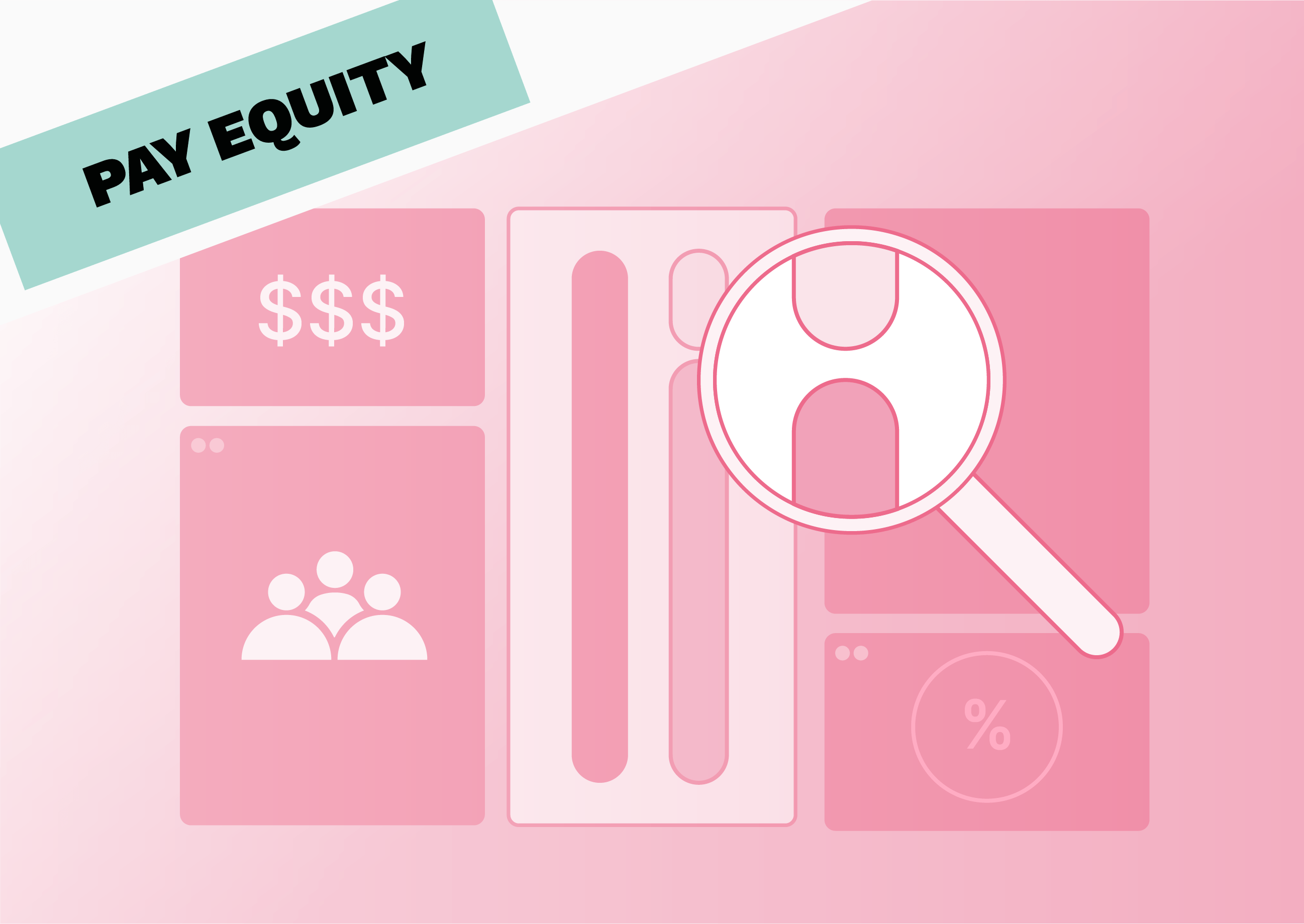Key points:
- The formula is simple, but the inputs determine everything: Your 12% gap might be 2% adjusted (fair pay, poor representation) or 18% for bonuses (eligibility issues) – each number tells a different story.
- Documentation beats calculation: Regulators care less about your gap percentage than your ability to explain it – track every methodology decision for year-over-year comparisons.b
- Four calculations reveal part of the picture: Mean and median gaps show different problems, bonus gaps expose discretionary bias, and quartile distributions reveal exactly where women disappear from your pay structure.
You step into the boardroom, gender pay gap calculations in hand. You’re confident; you’ve done the calculations, dotted the i’s and crossed the t’s… only for one of the directors to ask you what any of this actually means.
A flurry of swear words is uttered under your breath, before you start scrambling for answers you simply don’t have. The CEO is shooting you daggers.
That’s because your 12% headline figure tells only half of the story. Dig deeper, and that number starts to look shaky. Especially when it's only 3% when adjusted for roles, yet skyrockets to 18% for bonuses, with women clustered in lower quartiles like they've hit an invisible ceiling.
Here's the truth: basic calculations tell you what's happening, but advanced analysis reveals why.
This guide walks you through the three metrics that transform confusing data into clear action plans: adjusted gap analysis, bonus gaps, and quartile distributions. Though, just to make sure we’re on the same page, check out our guide on calculating the gender pay gap using the official formula.
All good? Let’s go!
Adjusted vs unadjusted gender pay gaps
Let’s start off with some definitions, as knowing the difference between adjusted and unadjusted gender pay gaps is crucial to the accuracy of your reports. Take a look:
- An unadjusted gap is the raw difference in average pay across your entire organisation and across employee categories, which is what you report for compliance. Simply take all men, all women, calculate averages, and find the difference.
- Adjusted gap controls for legitimate pay factors (such as role, experience, location, education, and performance) to isolate unexplained differences. Compare like with like: senior developers to senior developers, five-year veterans to five-year veterans.
🤔 The gender pay gap specifically looks at the average salaries of both men and women, relative to the average earnings of men.
So, let’s say you found a 15% unadjusted gender pay gap, but it drops down to 2% when adjusted. Congrats! Looks like you’re compliant.
Don’t start celebrating yet, though. Because your organisation might still have issues with employee distribution. You might be paying fairly for equal work (at least for the most part, you’ve still got an unexplainable 2% gap), but that 15% and why it appeared in the first place still needs investigation.
Mastering bonus gap analysis
Everyone loves a bonus… well, except HR reps when they have to account for them in their gap analysis. And that’s because bonuses require separate calculations and reveal bigger problems than base pay gaps.
We’re not kidding either. Bonus gaps routinely exceed base pay gaps. Why? Discretionary decisions, unconscious performance bias, and eligibility criteria that accidentally exclude women (at least we hope they’re accidental).
It’s best to start with participation rates, as they reveal access issues immediately. Let’s say you were examining participation rates and found:
- 67% of men received bonuses.
- 45% of women received bonuses.
And look at that? Before you’ve even started any calculations, there’s a problem already. It’s enough to turn any HR rep into the Incredible HRulk. Granted, that’s unadjusted. We’ve still got some more math ahead of us.
Calculation methodology for bonus gap analysis
The calculation methodology is straightforward: In the EU, each variable pay component must be analysed separately - bonuses, commissions, long-term incentives, and spot awards each get their own gap calculation. This is usually because each type of bonus might reveal its own bias.
For instance, you might discover a 5% gap in annual bonuses but a 25% gap in spot awards, pointing to different underlying issues. Calculate both mean and median for each component type.
Four drivers explain most bonus gaps:
- Sales role imbalance: 80% male sales team earning commission skews everything.
- Executive incentives: Senior roles (mostly male) have 40% bonus potential versus 10% for junior roles.
- Maternity leave timing: Miss the eligibility period, miss the entire bonus.
- Performance rating bias: "Exceeds expectations" goes to 45% of men but only 28% of women.
We’d also be remiss not to include some quick fixes that can help reduce that bonus gap:
- Standardise eligibility criteria (remove manager discretion).
- Audit performance ratings for gender bias patterns.
- Pro-rate bonuses for parental leave.
- Set minimum bonus pools for all eligible roles.
- Review discretionary award distribution quarterly.
Bonus gaps are messy, but at least they’re easy to track and can generally be fixed relatively easily. Not so with our next metric…
Pay quartile distribution analysis
Now we move on to pay quartiles and distribution. So, what are they?
This kind of analysis shows exactly where women disappear from your organisation's pay structure – information that average calculations hide.
Thankfully, the calculation couldn't be simpler. Rank all employees by hourly pay from lowest to highest. Divide into four equal groups. Calculate the gender proportion in each quartile. Done.
What you find usually follows predictable patterns:
Pattern recognition guide
As you can see, fixing these patterns can be difficult and often requires a ton of planning and investment. But it’s all for the greater good (the greater good) in creating a more equitable workplace.
Context factors and industry benchmarking
Let’s talk a little about raw gender pay gap calculations. Namely, do those calculations compare the same job?
The short answer is no. But that's kind of the point. Raw calculations reveal your total organisational challenge, not individual pay decisions.
That’s why you need to do some industry benchmarking. Let’s consider that tech companies might average a 15% gap, healthcare runs 8%, and finance hits 23%. Moreover, comparing your 12% gap to Google's 20% or the NHS's 5% without context misleads everyone. Especially since each industry has its own unique geographic distribution, workforce composition, and clustering.
Workforce composition drives the numbers
Part-time prevalence changes everything. When 60% of your female workforce works part-time versus 10% of men, this creates structural pay gaps even with identical hourly rates. Part-time roles often lack bonus eligibility, miss out on promotions, and cluster in lower-paid functions.
The gap calculation captures this disparity, but the solution isn't simply "pay part-timers more per hour" – it's understanding why women dominate part-time work in your organisation.
Geographic distribution adds another layer of complexity. A company's Berlin headquarters showing an 11% gap versus 19% in Barcelona could reflect multiple factors: different local markets, varying role distributions between offices, historical hiring practices, or yes, potentially discriminatory management practices in specific locations.
Never assume geography explains away gaps. Instead, investigate each location's unique dynamics: who gets hired for which roles, who gets promoted, and whether local management practices need scrutiny.
Calculate your "motherhood penalty"
Here's the uncomfortable maths few companies track:
The motherhood penalty. It sounds exactly as bad as it sounds. Women see an 8% reduction in earnings in the first five years after giving birth… What a way to thank the mothers of the next generation of workers.
Additionally, two careers that started identically diverge by 20-30% after two parental leaves, as these women might miss promotional opportunities or don’t have their pay adjusted once they’re back. Track this by comparing women with and without career breaks – the difference exposes your organisational bias against parents.
Occupational clustering
Even with perfect equal pay within roles, gaps persist when women concentrate in lower-paid functions.
This occupational clustering creates a gender pay gap even when everyone in the same role earns identical rates. Your total organisational gap actually comes from two distinct sources:
- Role distribution effect: The gap is created purely because women cluster in lower-paid functions
- Within-role pay gap: Any remaining gap when comparing men and women in the same roles
For example, if your organisation shows a 14% total gap, analysis might reveal:
- 9% comes from women being concentrated in HR and Marketing rather than Engineering
- 5% comes from women earning less than men, even within the same roles
💡Different problems need different solutions. Pay audits fix the 5%. Career development and hiring practices fix the 9%.
From analysis to strategic action
After all this, we bet you’re asking: how do you solve the gender pay gap? Well, you can start by matching specific interventions to your actual problems. And that doesn’t mean throwing generic "diversity initiatives" at complex structural issues.
Here’s how you might do that:
- High adjusted gap (>5%)? Immediate pay corrections required.
- Quartile clustering? First diagnose the cause, then match your intervention. If 70% of women sit in your bottom quartile due to occupational segregation, you need targeted hiring initiatives for higher-paid functions. If it's progression barriers within the same career path, create structured advancement programmes.
- Bonus gaps exceeding base gaps? Eligibility review. Strip manager discretion from bonus decisions, standardise criteria, and pro-rate for parental leave.
It’s a good idea to structure your fixes around the amount of effort you put in, versus the impact.
Those quick wins should be your goal at first, but don’t ignore the longer-term investments. While they take a bit more planning, showing you're putting in the work will encourage greater loyalty from your existing employees and provide you with huge advantages in terms of recruitment.
🥱Your solutions should actually be addressing the problem. Skip the generic diversity training and the mentorship without proper progression paths; your employees and stakeholders want to see real progress, not pointless posturing!
Stakeholder communication that works
With that in mind, let’s remember that honesty is the best policy. And that’s especially true when it comes to your stakeholders. They want to know exactly how you reached your numbers and what makes up the gap.
So break down your gap honestly: "Our 14% gap = 8% representation + 4% career breaks + 2% unexplained".
This transparency builds trust while demonstrating your understanding of the components. Especially if you provide a solid action plan on how those metrics can be reduced.
Rather than your CEO shooting you daggers this time around, they might be looking at you with admiration. And that’s got to be worth its weight in gold, right?
Automating advanced analysis with pay equity tools
Hopefully, over the course of this piece, we’ve impressed on you just how much goes into a good gender pay gap analysis.
Advanced analysis transforms a confusing 12% headline into actionable insights. Your gap might be 2% adjusted, 18% for bonuses (review eligibility criteria), or concentrated in lower quartiles (remove progression barriers). Each metric answers different stakeholder questions and drives specific interventions.
The only problem is that regression models and temporal tracking become unmanageable for organisations with 200+ employees. One formula error invalidates months of work. Version control becomes a full-time job. So, how do you avoid this and keep your sanity? Well, by finding the right pay equity tool!
Figures connect HRIS, performance, and compensation data for automated adjusted gap calculations and dynamic quartile tracking. What took weeks in Excel happens in minutes, with full audit trails. Don’t just take our word for it:
“Figures helped us build a full salary compensation structure, making it easier to transition into an open, fair compensation model.”
– Emma Herrero, HR Lead at Phiture
The business case writes itself: 3 in 5 employees won't apply to companies with known pay gaps. Advanced analysis moves you from defensive compliance to strategic talent management.
So, want to move beyond basic calculations? Join the 10,000+ users and discover how Figures transforms complex pay data into clear, actionable equity plans by booking a demo today.
{{ cta }}
Summarize this article with AI
No time to read it all? Get a clear, structured, and actionable summary in one click.






